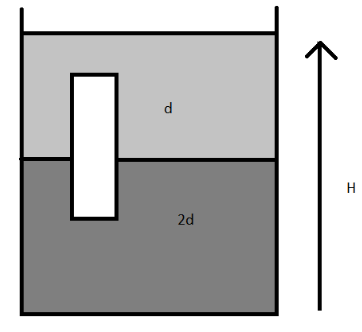
A homogeneous solid cylinder of length L $ (Less Than\dfrac{H}{2}) $ , cross sectional area A is immersed such that it floats with its axis vertical at the liquid-liquid interface with length $ \dfrac{L}{4} $ in the density liquid as shown in the figure. The lower density liquid is open to atmosphere having pressure $ {P_0} $ .then, density D of solid is given by

A.$\dfrac{5}{4}d \\$
B.$\dfrac{4}{5}d \\$
C.$4d \\$
D.$\dfrac{d}{5} \\ $

Answer
528.9k+ views
Hint : Here if we consider the vertical equilibrium of the cylinder, weight of the cylinder is equal to the developed upthrust due to upper liquid and the upthrust due to the lower liquid. Weight of two liquids displaced is equal to the right of the block.
Complete Step By Step Answer:
According to the law of floatation, weight of the block is equal to the weight of the liquid displaced.
Here in the given question;
Weight of two liquids displaced is equal to the right of the block.
Weight of the block is equal to $ LADg $
Weight of the first liquid is $ \dfrac{L}{4}A(2d)g $ .
Weight of the second liquid is $ \dfrac{{3L}}{4}Adg $ .
Now;
$ LADg = \dfrac{L}{4}A(2d)g + \dfrac{{3L}}{4}Adg \\
\Rightarrow D = \dfrac{1}{2}d + \dfrac{3}{4}d = \dfrac{5}{4}d \\ $
Hence, the density of the given solid is $ \dfrac{5}{4}d $ .
Option A is the correct answer.
Note :
Law of flotation – when anybody displaces a weight of water equal to the weight of itself, it starts floating. This is called the principle of flotation and Archimedes principle equates that the above equation as buoyant force to the weight of the fluid displaced.
Weight of two liquids displaced is equal to the right of the block. Weight of the cylinder is equal to the developed upthrust due to upper liquid and the upthrust due to the lower liquid.
Complete Step By Step Answer:
According to the law of floatation, weight of the block is equal to the weight of the liquid displaced.
Here in the given question;
Weight of two liquids displaced is equal to the right of the block.
Weight of the block is equal to $ LADg $
Weight of the first liquid is $ \dfrac{L}{4}A(2d)g $ .
Weight of the second liquid is $ \dfrac{{3L}}{4}Adg $ .
Now;
$ LADg = \dfrac{L}{4}A(2d)g + \dfrac{{3L}}{4}Adg \\
\Rightarrow D = \dfrac{1}{2}d + \dfrac{3}{4}d = \dfrac{5}{4}d \\ $
Hence, the density of the given solid is $ \dfrac{5}{4}d $ .
Option A is the correct answer.
Note :
Law of flotation – when anybody displaces a weight of water equal to the weight of itself, it starts floating. This is called the principle of flotation and Archimedes principle equates that the above equation as buoyant force to the weight of the fluid displaced.
Weight of two liquids displaced is equal to the right of the block. Weight of the cylinder is equal to the developed upthrust due to upper liquid and the upthrust due to the lower liquid.
Recently Updated Pages
Master Class 11 Economics: Engaging Questions & Answers for Success

Master Class 11 English: Engaging Questions & Answers for Success

Master Class 11 Social Science: Engaging Questions & Answers for Success

Master Class 11 Biology: Engaging Questions & Answers for Success

Class 11 Question and Answer - Your Ultimate Solutions Guide

Master Class 11 Business Studies: Engaging Questions & Answers for Success

Trending doubts
10 examples of friction in our daily life

One Metric ton is equal to kg A 10000 B 1000 C 100 class 11 physics CBSE

Difference Between Prokaryotic Cells and Eukaryotic Cells

1 Quintal is equal to a 110 kg b 10 kg c 100kg d 1000 class 11 physics CBSE

Explain zero factorial class 11 maths CBSE

What is a periderm How does periderm formation take class 11 biology CBSE




